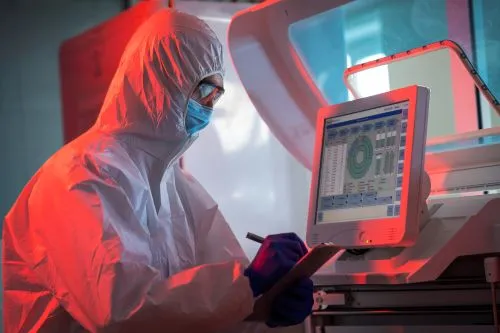935

Antimicrobial Packaging: A Breakthrough for Fresh Meat and Dairy Products
Fresh products have a short shelf life, as they provide an excellent growth environment for a wide range of microorganisms. As a result, microbial spoilage—which causes significant food supply losses—has become a major ethical and economic concern worldwide.
This issue was studied by a team of scientists from the Institute of Biosciences and Bioresources in Naples, comprising Marta Gogliettino, Marco Balestrieri, Aniello Anastasio, and Luca De Stefano. Their research, titled "Extending the Shelf-Life of Meat and Dairy Products via PET-Modified Packaging Activated With the Antimicrobial Peptide", was funded by the Italian National Research Council. Here are the main findings.
A Viable Solution
Antimicrobial packaging offers a promising solution to this economic and food safety issue, particularly for fresh meat and dairy products, by extending shelf life and improving product quality and safety.
The aim of the study was to investigate the effects of food-contact polyethylene terephthalate (PET) surfaces functionalized with an antimicrobial peptide—specifically, a mitochondria-targeted peptide (MTP1)—on reducing spoilage-related microbial populations and enhancing shelf life. The researchers tested its application on perishable foods such as ricotta cheese and beef.
The modified polymers were characterized in terms of plasma activation procedures through water contact angle (WCA) measurements and attenuated total reflectance Fourier-transform infrared spectroscopy (ATR-FTIR).
The results showed that MTP1-functionalized PET surfaces (MTP1-PETs) exhibited strong antimicrobial activity against spoilage microorganisms, with no cytotoxicity observed on a human colon cancer cell line. Additionally, the active polymers demonstrated high storage stability and reusability.
This study provides valuable insight for developing alternative antimicrobial packaging to improve the microbial quality and safety of perishable foods during storage.
The Core Limitation
The limited shelf life of fresh foods is a major barrier to their commercialization, primarily due to high nutrient content and surface moisture, which contribute to rapid spoilage and the proliferation of pathogenic microorganisms.
Indeed, microbial growth on food surfaces is a well-known cause of undesirable changes in flavor, aroma, and other organoleptic properties, leading to reduced quality and shortened commercial life.
While the exact economic loss due to food spoilage is hard to estimate, it is clearly a massive burden. According to FAO (Cichello, 2015; Bondi et al., 2017), global food waste reaches an estimated 1.3 billion tonnes annually (Blackburn, 2016).
Even a 20–25% reduction in food waste could save between €120 billion and €300 billion per year, according to a recent report by the UK’s Waste and Resources Action Programme (WRAP).
Refrigeration is essential for preserving the microbial quality of fresh products, but it alone does not ensure a long shelf life—often only around 4–5 days for certain foods.
This situation presents a challenge for the food industry to develop innovative strategies that improve preservation and extend storage time while maintaining the natural appearance and safety of food by reducing or eliminating spoilage bacteria.
One major advancement in this field is active packaging, which not only acts as a barrier to moisture, water vapor, and gases but also serves as a carrier for active substances that enhance shelf life and ensure food quality and safety (Suppakul et al., 2013).
A Revived Innovative Concept
Active packaging is one of the most relevant innovations for enhancing consumer satisfaction. It can be defined as a packaging system in which the product, the packaging, and the environment interact positively to extend shelf life and/or improve safety and sensory properties, while maintaining food quality.
Among active packaging technologies, antimicrobial packaging is considered one of the most promising.
These systems are based on immobilizing antimicrobial agents onto polymer surfaces. Their popularity has grown due to the wide variety of available polymer compositions, allowing for product-specific packaging solutions.
One of the most commonly used materials in food packaging is polyethylene terephthalate (PET)—a long-chain, chemically inert polymer known for its favorable physical properties and suitability in various food applications.
However, PET’s chemical inertness requires surface activation and functionalization, such as cold plasma treatment, before bioactive compounds—like essential oils, plant extracts, bacteriocins, or enzymes—can be immobilized.
Some antimicrobial packaging systems use immobilized antimicrobial peptides (AMPs) to suppress microbial growth (Malhotra et al., 2015).
A Chemically Diverse Family
AMPs are part of the innate immune system of all multicellular organisms and represent a chemically and structurally diverse group. They have been isolated from a wide range of sources, including animals, plants, bacteria, fungi, and viruses.
Nevertheless, nearly all AMPs share three key characteristics: small size, strong cationic nature, and a tendency to adopt amphipathic structures. These physicochemical properties enable AMPs to interact with negatively charged microbial membranes.
To serve as effective coating agents, AMPs must retain broad-spectrum antimicrobial activity once bound to packaging materials.
Because many natural peptides cannot maintain these properties, new, more efficient AMPs must be developed to enhance food safety and shelf life.
One such peptide is MTP1, a 15-mer peptide derived from a human CPT sequence. MTP1 has shown remarkable stability across a wide pH (2–10) and temperature range (15–90°C) during extended incubation.
Moreover, MTP1 adopts alpha-helix/beta-sheet structures in membrane-mimicking solutions, as confirmed by CD analyses, and has demonstrated strong bactericidal activity against Listeria monocytogenes—a major foodborne pathogen.
Materials and Methods
The study employed the following methods:
- Plasma treatment (PET films were cut into disc-shaped samples for treatment and peptide immobilization).
- Water contact angle (WCA) measurements (performed using a sessile drop method with an OCA 15EC system, DataPhysics Instruments GmbH, Filderstadt, Germany).
- ATR-FTIR spectroscopy (conducted within the spectral range 4000–650 cm⁻¹ at 4 cm⁻¹ resolution using a Thermo-Nicolet Continuum XL spectrometer, Thermo Scientific, USA).
- MTP1 immobilization (PET films were incubated in 50 μM MTP1 solution prepared in 10 mM phosphate buffer, pH 7.0, at 25°C for 24 hours following oxygen plasma exposure).
- Immobilization yield analysis (carried out using reverse-phase high-performance liquid chromatography, RP-HPLC, Shimadzu, Milan, Italy).
- Release testing (assessed using RP-HPLC as described above).
- Shelf life testing on dairy products (performed on three randomly selected buffalo ricotta cheese samples, 200 g each).
- Beef shelf life testing (using meat from a 34-month-old buffalo slaughtered in an EU-authorized facility, weighing approx. 470 kg).
- Physico-chemical analysis (pH measured using a Crison-Micro TT 2022 digital pH meter, Crison Instruments, Barcelona, Spain).
Additional analyses included rheology, sensory evaluation, cytotoxicity tests, and statistical analysis.
Results and Discussion
A PET surface immobilization platform using previously characterized MTP1 (Palmieri et al., 2016) was developed by exposing PET discs to radiofrequency cold plasma, with variable process parameters: exposure time (T), RF power, and molecular oxygen pressure (P).
To evaluate surface hydrophilicity after treatment, WCA measurements were taken. Prior to plasma treatment, WCA was 89 ± 3°, confirming PET’s hydrophobic nature. After optimal plasma conditions (50 W, 10 s exposure), WCA dropped to 76 ± 2°, indicating significantly increased hydrophilicity.
Notably, when higher RF power (300 W) and longer exposure times (100–300 s) were applied, a macroscopic change in PET surface roughness was observed, indicating material degradation.
After plasma treatment, PET samples were incubated for 24 hours in MTP1 buffer solution. Coupling efficiency was confirmed by a sharp WCA drop to 36 ± 3°, reflecting enhanced surface hydrophilicity due to peptide functionalization.
This change resulted from the reaction of free chemical groups in MTP1 (typically -COOH and -NH₂) with reactive groups (-COOH, -OH) on the plasma-activated PET surface (De Stefano et al., 2009).
In contrast, PET samples that were not plasma-treated but incubated with MTP1 under the same conditions retained their original WCA (75 ± 1°), indicating negligible non-specific peptide adsorption.
FTIR analysis also confirmed successful MTP1 bioconjugation. Non-activated PET displayed peaks corresponding to C–C, C–H, and C–O stretching. After plasma treatment, new -OH peaks appeared, consistent with increased surface wettability.
The presence of peptide-specific absorption bands (Amide I and II)—arising from peptide bonds in the MTP1 sequence—confirmed covalent peptide binding on PET surfaces. The Amide I band (1650–1560 cm⁻¹) reflected C=O stretching, while Amide II (1580–1490 cm⁻¹) indicated N–H bending.
Control samples (no plasma treatment) showed FTIR spectra similar to untreated PET, confirming the necessity of plasma activation for effective peptide immobilization.
(Photo: Freepik)




